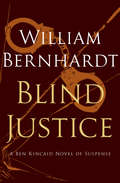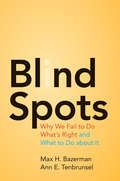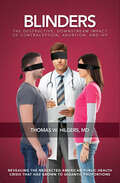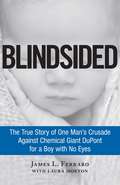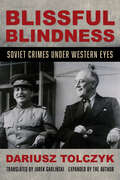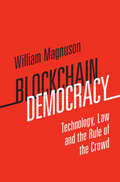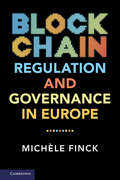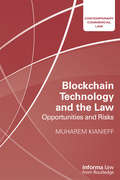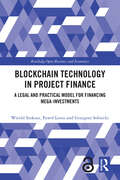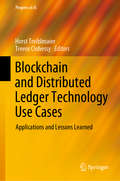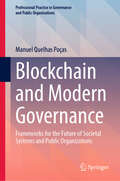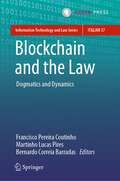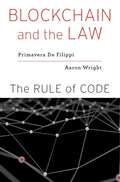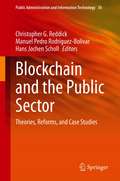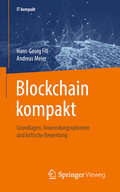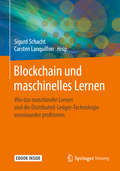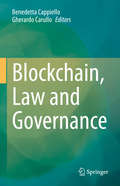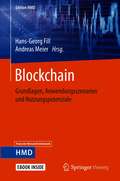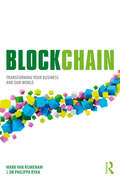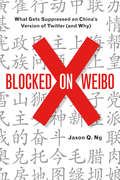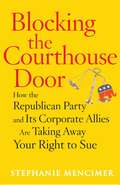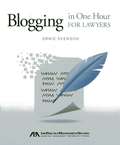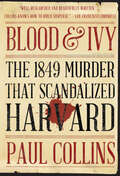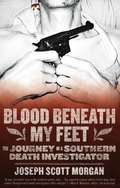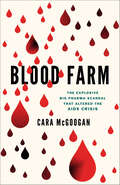- Table View
- List View
Blind Justice (The Ben Kincaid Novels #2)
by William BernhardtFrom &“a first-rate storyteller&”: An ex-corporate lawyer in Oklahoma starts a new career defending the innocent (Tulsa World). Ben Kincaid is too honest for corporate law. When his refusal to compromise his ideals gets him tossed out of Tulsa&’s largest, most corrupt firm, he hangs out his shingle on the rough side of town. He works for peanuts—and occasionally chickens—but is safe in the knowledge that he is helping people who have nowhere else to turn. His newest client is also one of his oldest friends: Christina McCall, a onetime colleague in the world of corporate law. Christina is beautiful, daringly dressed, and on trial for a murder she didn&’t commit. The last thing Christina remembers is the smell of her mother&’s perfume. When she comes out of her stupor, her client is dead, the gun is in her hand, and the police are cuffing her wrists. Proving her innocence may be an impossible, but the impossible is becoming Kincaid&’s specialty.
Blind Spots: Why We Fail to Do What's Right and What to Do about It
by Max H. Bazerman Ann E. TenbrunselWhen confronted with an ethical dilemma, most of us like to think we would stand up for our principles. But we are not as ethical as we think we are. In Blind Spots, leading business ethicists Max Bazerman and Ann Tenbrunsel examine the ways we overestimate our ability to do what is right and how we act unethically without meaning to. From the collapse of Enron and corruption in the tobacco industry, to sales of the defective Ford Pinto, the downfall of Bernard Madoff, and the Challenger space shuttle disaster, the authors investigate the nature of ethical failures in the business world and beyond, and illustrate how we can become more ethical, bridging the gap between who we are and who we want to be. Explaining why traditional approaches to ethics don't work, the book considers how blind spots like ethical fading--the removal of ethics from the decision--making process--have led to tragedies and scandals such as the Challenger space shuttle disaster, steroid use in Major League Baseball, the crash in the financial markets, and the energy crisis. The authors demonstrate how ethical standards shift, how we neglect to notice and act on the unethical behavior of others, and how compliance initiatives can actually promote unethical behavior. They argue that scandals will continue to emerge unless such approaches take into account the psychology of individuals faced with ethical dilemmas. Distinguishing our "should self" (the person who knows what is correct) from our "want self" (the person who ends up making decisions), the authors point out ethical sinkholes that create questionable actions. Suggesting innovative individual and group tactics for improving human judgment, Blind Spots shows us how to secure a place for ethics in our workplaces, institutions, and daily lives.
Blinders: The Destructive, Downstream Impact of Contraception, Abortion, and IVF
by Thomas W. HilgersOver the last 50 or 60 years, there has appeared a directional shift in the medical and social culture of the United States. We see it in the news programs every night, sometimes several times a night. Often there are generic reasons given for these changes such as “poverty and hopelessness.” But could there be other reasons? Could the medical profession be playing an important role in the violence and destructiveness of this cultural shift? Has there been any critical self-examination by the medical profession which usually demands evidence-based conclusions to be assessed? Or are there some questions that are too difficult for individuals to investigate, not because it’s impossible to investigate them, but because it can be painful and because the attitudes of a collective group of colleagues may be preventing these questions from being asked. It is as if we have BLINDERS on!This book makes an attempt to address some new questions that have rarely been asked but should be. This book, with a full-color interior, takes an objective look at data that has been produced by mostly government-based statistical gathering systems, some published in peer-reviewed medical journals and even some in news reports.
Blindsided: The True Story of One Man's Crusade Against Chemical Giant DuPont for a Boy with No Eyes
by James L. FerraroIn 1996, an unprecedented decade-long courtroom battle was waged in Florida to help bring justice and hope to the family of a young boy born with no eyes after his mother was doused outside of a local u-pick farm by a chemical fungicide believed to have caused his birth defect and the birth defects of many other children. It was a battle that nearly everyone but attorney Jim Ferraro deemed unwinnable. After all, it involved one of the world's most powerful industrial giants. In the process, it was a fight that changed the landscape of tort law forever. Before it was over Castillo-vs-DuPont would go down in history as the first and one of the most important cases of its kind, setting precedent and also sparking a crucial debate over the questionable use of what is known as the "junk-science defense." Blindsided is a real life David and Goliath story-a true courtroom drama for the ages.
Blissful Blindness: Soviet Crimes under Western Eyes
by Dariusz TołczykThe most heinous Soviet crimes – the Red Terror, brutal collectivization, the Great Famine, the Gulag, Stalin's Great Terror, mass deportations, and other atrocities – were treated in the West as a controversial topic. With the Cold War dichotomy of Western democracy versus Soviet communism deeply imprinted in our minds, we are not always aware that these crimes were very often questioned, dismissed, denied, sometimes rationalized, and even outright glorified in the Western world. Facing a choice of whom to believe –the survivors or Soviet propaganda– many Western opinion leaders chose in favor of Soviet propaganda. Even those who did not believe it behaved sometimes as if they did. Blissful Blindness explores Western reactions (and lack thereof) to Soviet crimes from the Bolshevik revolution to the collapse of Soviet communism in order to understand ideological, political, economic, cultural, personal, and other motivations behind this puzzling phenomenon of willful ignorance. But the significance of Dariusz Tolczyk's book reaches beyond its direct historical focus. Written for audiences not limited to scholars and specialists, this book not only opens one's eyes to rarely examined aspects of the twentieth century but also helps one see how astonishingly relevant this topic is in our contemporary world.
Blockchain Democracy: Technology, Law and the Rule of the Crowd
by William MagnusonIn Blockchain Democracy, William Magnuson provides a breathtaking tour of the world of blockchain and bitcoin, from their origins in the online scribblings of a shadowy figure named Satoshi Nakamoto, to their furious rise and dramatic crash in the 2010s, to their ignominious connections to the dark web and online crime. Magnuson argues that blockchain's popularity stands as a testament both to the depth of distrust of government today, and also to the fervent and undying belief that technology and the world of cyberspace can provide an answer. He demonstrates how blockchain's failings provide broader lessons about what happens when technology runs up against the stubborn realities of law, markets, and human nature. This book should be read by anyone interested in understanding how technology is changing our democracy, and how democracy is changing our technology.
Blockchain Regulation and Governance in Europe
by Michèle FinckIn Blockchain Regulation and Governance in Europe, Michèle Finck examines the relationship between blockchain technology and EU law and introduces the theme of blockchain governance. The book provides a general introduction to blockchains as both a regulatable and a regulatory technology and outlines the interaction between distributed ledger technology and specific areas of EU law, such as the General Data Protection Regulation. It should be read by anyone interested in EU law, the relationship between law, innovation and technology, and technology governance.
Blockchain Technology and the Law: Opportunities and Risks (Contemporary Commercial Law)
by Muharem KianieffBlockchain Technology and the Law: Opportunities and Risks is one of the first texts to offer a critical analysis of Blockchain and the legal and economic challenges faced by this new technology. This book will offer those who are unfamiliar with Blockchain an introduction as to how the technology works and will demonstrate how a legal framework that governs it can be used to ensure that it can be successfully deployed. Discussions included in this book: - an introduction to smart contracts, and their potential, from a commercial and consumer law perspective, to change the nature of transactions between parties; - the impact that Blockchain has already had on financial services, and the possible consumer risks and macro-economic issues that may arise in the future; - the challenges that are facing global securities regulators with the development of Initial Coin Offerings and the ongoing risks that they pose to the investing public; - the risk of significant privacy breaches due to the online public nature of Blockchain; and - the future of Blockchain technology. Of interest to academics, policy-makers, technology developers and legal practitioners, this book will provide a thorough examination of Blockchain technology in relation to the law from a comparative perspective with a focus on the United Kingdom, Canada and the United States.
Blockchain Technology in Project Finance: A Legal and Practical Model for Financing Mega-Investments (Routledge Open Business and Economics)
by Witold Srokosz Paweł Lenio Grzegorz SobieckiThere is currently no comprehensive scientific study that addresses the problem of financing projects using Distributed Ledger (blockchain) Technology (DLT) that are not themselves embedded in the blockchain ecosystem, particularly in the context of long-term and capital-intensive investments. This book fills this gap. It poses a number of research questions such as what financing model/mechanism is the most effective in the long term where very large financial resources are concerned; are there appropriate legal regulations in place; and can DLT (blockchain) technology provide usability and solutions that can be used in the process of financing capital-intensive investments?The book ultimately shows that it is possible to build a legal and economic model that would effectively enable the financing of long-term and capital-intensive investments, based on a specially prepared integrated platform operating on the basis of blockchain technology. As a result of the mechanisms of smart contracts, the platform would enable, the issuance and service of tokens, including equity tokens, but also auxiliary and payment or utility tokens, and the automation of relations between stakeholders. It would also allow the creation of a virtual decentralized autonomous organization (DAO) that would control the implementation of the project, and a decentralized exchange that would enable token trading.The core readership for the book is academics, scholars and researchers in the fields of economics, finance and law, particularly those focused on blockchain technology, distributed ledger systems, and innovative financing mechanisms for large-scale investments. Policymakers and regulators involved in developing policies and legal frameworks for blockchain technology, cryptocurrencies, and financial innovation would find it to be a practical reference.
Blockchain and Distributed Ledger Technology Use Cases: Applications and Lessons Learned (Progress in IS)
by Horst Treiblmaier Trevor ClohessyBlockchain and other trustless systems have gone from being relatively obscure technologies, which were only known to a small community of computer scientists and cryptologists, to mainstream phenomena that are now considered powerful game changers for many industries. This book explores and assesses real-world use cases and case studies on blockchain and related technologies. The studies describe the respective applications and address how these technologies have been deployed, the rationale behind their application, and finally, their outcomes. The book shares a wealth of experiences and lessons learned regarding financial markets, energy, SCM, healthcare, law and compliance. Given its scope, it is chiefly intended for academics and practitioners who want to learn more about blockchain applications.
Blockchain and Modern Governance: Frameworks for the Future of Societal Systems and Public Organizations (Professional Practice in Governance and Public Organizations)
by Manuel Quelhas PoçasThis book shows how blockchain technology can transform the foundational systems of our society. Written by an industry expert with a background in political science, international relations, law, management, and technology, the book merges social, political, economic, and legal theories with technological expertise to present a groundbreaking framework for using blockchain in governance and public organizations. Imagine a country as a digital space where humans and resources interact seamlessly. This book explores such possibilities, illustrating how blockchain can redefine governance beyond physical borders. Addressing the urgent need for adaptive solutions in a globally interconnected world, the author provides a strategic roadmap for implementing blockchain in public governance. With clear explanations, real-world examples, and practical applications, this book will inspire and guide professionals and policy-makers seeking to utilize blockchain technology for innovative governance solutions.
Blockchain and the Law: Dogmatics and Dynamics (Information Technology and Law Series #37)
by Martinho Lucas Pires Francisco Pereira Coutinho Bernardo Correia BarradasThis book discusses the dogmatic (that what is settled) and the dynamic (that what is changing) aspects of the relationship between blockchain and the law from a critical perspective. With contributions from legal and financial experts involved in both academy and business from Europe, Africa and North and South America, the book looks at the abstract complexities and practical challenges of regulating blockchain technology and its developments, such as crypto assets and smart contracts, from the perspectives of financial, tax, civil, and international law. Moreover, the book also delves into some exciting and cutting-edge related topics such as blockchain applications for litigation, CBDC and elections.The volume offers insightful considerations that will be helpful for legal practitioners involved in the crypto and Distributed Ledger Technology (DLT) phenomenon.Francisco Pereira Coutinho is Associate Professor at the Nova School of Law in Lisbon, Portugal.Martinho Lucas Pires is Teaching Assistant in the Department of Law of the Universidade Católica Portuguesa in Lisbon, Portugal.Bernardo Correia Barradas is a Lawyer and Senior Legal Advisor in payments in Washington DC, United States.
Blockchain and the Law: The Rule of Code
by Primavera De De FilippiSince Bitcoin appeared in 2009, the digital currency has been hailed as an Internet marvel and decried as the preferred transaction vehicle for all manner of criminals. It has left nearly everyone without a computer science degree confused: Just how do you “mine” money from ones and zeros? The answer lies in a technology called blockchain, which can be used for much more than Bitcoin. A general-purpose tool for creating secure, decentralized, peer-to-peer applications, blockchain technology has been compared to the Internet itself in both form and impact. Some have said this tool may change society as we know it. Blockchains are being used to create autonomous computer programs known as “smart contracts,” to expedite payments, to create financial instruments, to organize the exchange of data and information, and to facilitate interactions between humans and machines. The technology could affect governance itself, by supporting new organizational structures that promote more democratic and participatory decision making. Primavera De Filippi and Aaron Wright acknowledge this potential and urge the law to catch up. That is because disintermediation—a blockchain’s greatest asset—subverts critical regulation. By cutting out middlemen, such as large online operators and multinational corporations, blockchains run the risk of undermining the capacity of governmental authorities to supervise activities in banking, commerce, law, and other vital areas. De Filippi and Wright welcome the new possibilities inherent in blockchains. But as Blockchain and the Law makes clear, the technology cannot be harnessed productively without new rules and new approaches to legal thinking.
Blockchain and the Public Sector: Theories, Reforms, and Case Studies (Public Administration and Information Technology #36)
by Christopher G. Reddick Manuel Pedro Rodríguez-Bolívar Hans Jochen SchollThis book discusses blockchain technology and its potential applications in digital government and the public sector. With its robust infrastructure and append-only record system, blockchain technology is being increasingly employed in the public sector, specifically where trustworthiness and security are of importance. Written by leading scholars and practitioners, this edited volume presents challenges, benefits, regulations, frameworks, taxonomies, and applications of blockchain technology in the public domain.Specifically, the book analyzes the implementation of blockchain technologies in the public sector and the potential reforms it would bring. It discusses emerging technologies and their role in the implementation of blockchain technologies in the public sector. The book details the role of blockchain in the creation of public value in the delivery of public sector services. The book analyzes effects, impacts, and outcomes from the implementation of blockchain technologies in the public sector in select case studies.Providing up-to-date information on important developments regarding blockchain in government around the world, this volume will appeal to academics, researchers, policy-makers, public managers, international organizations, and technical experts looking to understand how blockchain can enhance public service delivery.
Blockchain kompakt: Grundlagen, Anwendungsoptionen und kritische Bewertung (IT kompakt)
by Andreas Meier Hans-Georg FillLernen Sie in diesem Fachbuch mehr über die Grundlagen von BlockchainSie interessieren sich für Kryptowährungen durch Blockchain-Technologie? Aber irgendwie erscheint Ihnen die Thematik wie ein Buch mit sieben Siegeln? Dieses Fachbuch von Hans-Georg Fill und Andreas Meier liefert Ihnen einen Überblick rund um Blockchain. Es erläutert detailliert und übersichtlich die Grundlagen zu folgenden Themenfeldern:Datenstrukturen wie Hash-Funktionen und -BäumeDigitale SignaturFunktionenKonsensalgorithmenetc.Blockchains sind jedoch nicht nur ein Teil von Kryptowährungen. Es handelt sich um ein digitales Buchungssystem. Die Technologie von Ethereum ist daher für viele Unternehmen äußerst interessant (Stichwort Smart Contracts, Smart Grid, Smart Cities). Das Fachbuch über Blockchain ist somit genau das Richtige für Sie, wenn Sie Verbesserungen im eigenen Unternehmen, der Verwaltung oder im öffentlichen Leben vornehmen oder alternative Lösungen angehen wollen.Konzepte und Anwendungen der KryptographieIn den sechs Kapiteln des Fachbuches über Blockchain liefern Ihnen die Autoren Antworten auf verschiedene rechtliche Fragen. Sie befassen sich im Rahmen ihrer Ausführungen kritisch mit der Blockchain-Technologie und zeigen Ihnen wichtige Anwendungsoptionen. Sie erhalten einen fundierten Überblick über folgende Themenfelder:Motivation Betrugsprävention Grundlagen zur Blockchain-Technologie Aufbau und Funktion der BlockchainAnwendungsoptionen Rechtliche FragenKritische EinschätzungDieses Fachbuch über Blockchain richtet sich an Führungsverantwortliche, Projektleiter und Interessierte, die sich einen Überblick über das Potenzial der Blockchain-Technologie verschaffen möchten.
Blockchain und maschinelles Lernen: Wie das maschinelle Lernen und die Distributed-Ledger-Technologie voneinander profitieren
by Sigurd Schacht Carsten LanquillonDurch Bitcoin wurde die Blockchain als zugrundeliegende Technologie bekannt. Sie zählt zu den Distributed-Ledger-Technologien, die zukünftig viele Bereiche des wirtschaftlichen Handels beeinflussen werden. So bergen dezentrale autonome Anwendungen enormes Potenzial, nicht nur Prozesse, sondern auch Vertragsabstimmungen zu automatisieren. Beispielsweise kann ein automatisiertes wirtschaftliches Handeln zwischen Maschinen ermöglicht werden. Um einen derart hohen Automatisierungsgrad zu erreichen, müssen datenbasierte Entscheidungen autonom – ohne menschliches Zutun – getroffen werden. Maschinelle Lernverfahren können dabei eine zentrale Komponente bei der Entscheidungsfindung einnehmen. Das Buch stellt erstmalig die komplementären Themengebiete Distributed-Ledger-Technologie und maschinelles Lernen gegenüber und zeigt auf, welches Potenzial freigesetzt werden kann, wenn beide Technologien zielführend miteinander verbunden werden. Das Buch ist eine unverzichtbare Lektüre für diejenigen, die sich tiefgreifendes Wissen in der Kombination beider Themengebiete aufbauen wollen, indem einerseits die theoretischen Grundlagen und andererseits auch mögliche Anwendungsszenarien dargestellt werden.
Blockchain, Law and Governance
by Benedetta Cappiello Gherardo CarulloThis volume explores from a legal perspective, how blockchain works. Perhaps more than ever before, this new technology requires us to take a multidisciplinary approach. The contributing authors, which include distinguished academics, public officials from important national authorities, and market operators, discuss and demonstrate how this technology can be a driver of innovation and yield positive effects in our societies, legal systems and economic/financial system. In particular, they present critical analyses of the potential benefits and legal risks of distributed ledger technology, while also assessing the opportunities offered by blockchain, and possible modes of regulating it. Accordingly, the discussions chiefly focus on the law and governance of blockchain, and thus on the paradigm shift that this technology can bring about.
Blockchain: Grundlagen, Anwendungsszenarien und Nutzungspotenziale (Edition HMD)
by Andreas Meier Hans-Georg FillSowohl in der Praxis als auch der wissenschaftlichen Forschung ist das Thema "Blockchain" aktuell von großem Interesse. Noch scheint sich die Technologie am Anfang ihrer Entwicklung zu befinden: Plattformen wie Bitcoin, Ethereum, Hyperledger Fabric, Libra, TradeLens oder andere weisen bereits einen beeindruckenden Reifegrad in ihrer technischen Entwicklung auf. Dennoch befinden sich erst wenige von ihnen bzw. darauf aufbauende Applikationen im produktiven Einsatz bei Unternehmen. Hier können nicht nur Forschende optimal dazu beitragen, neue Ideen zu entwickeln, noch nicht betrachtete Anwendungsfälle und -domänen zu untersuchen und erste Prototypen für den konkreten Einsatz zu entwickeln. Die Beiträge der vorliegenden Edition HMD bieten dazu einen umfassenden Überblick und zeigen die große Bandbreite an möglichen Anwendungsfeldern für Blockchains. Das Herausgeberwerk vermittelt somit die Grundlagen zur Blockchain-Technologie, widmet sich den Smart Contracts und beschreibt wichtige Anwendungsszenarien, erste Fallbeispiele und rechtliche Aspekte. Wie typisch für die Fachbuchreihe Edition HMD greifen die Beitragsautoren das Thema aus Sicht von Forschung und Praxis gleichermaßen auf. Ein Glossar mit den wichtigsten Begriffen rundet das Buch ab.
Blockchain: Transforming Your Business and Our World
by Mark Van Rijmenam Philippa RyanThe internet was envisaged as a decentralised global network, but in the past 25 years it has come to be controlled by a few, very powerful, centralised companies. Blockchain is a technological paradigm shift that allows secure, reliable, and direct information transfer between individuals, organisations, and things, so that we can manage, verify, and control the use of our own data. Blockchain also offers a new opportunity for humanity to fix some major problems. It can authenticate data, manage its analysis, and automate its use. With better data comes better decision-making. In this way, Blockchain can contribute to solving climate change, reduce voting fraud, fix our identity systems, improve fair trade, and give the poor an opportunity to improve their lives by monetising their (digital) capital. A world built upon peer-to-peer transactions and smart contracts can empower individuals and communities. This book offers a fresh perspective with which to consider this transformative technology. It describes how Blockchain can optimise the processes that run our society. It provides practical solutions to global problems and offers a roadmap to incorporate Blockchain in your business. It offers a blueprint for a better world. Filled with easy-to-understand examples, this book shows how Blockchain can take over where the internet has fallen short.
Blocked on Weibo
by Jason Q. NgThough often described with foreboding buzzwords such as "The Great Firewall" and the "censorship regime," Internet regulation in China is rarely either obvious or straightforward. This was the inspiration for China specialist Jason Q. Ng to write an innovative computer script that would make it possible to deduce just which terms are suppressed on China's most important social media site, Sina Weibo. The remarkable and groundbreaking result is Blocked on Weibo, which began as a highly praised blog and has been expanded here to list over 150 forbidden keywords, as well as offer possible explanations why the Chinese government would find these terms sensitive.As Ng explains, Weibo (roughly the equivalent of Twitter), with over 500 million registered accounts, censors hundreds of words and phrases, ranging from fairly obvious terms, including "tank" (a reference to the "Tank Man" who stared down the Chinese army in Tiananmen Square) and the names of top government officials (if they can't be found online, they can't be criticized), to deeply obscure references, including "hairy bacon" (a coded insult referring to Mao's embalmed body).With dozens of phrases that could get a Chinese Internet user invited to the local police station "for a cup of tea" (a euphemism for being detained by the authorities), Blocked on Weibo offers an invaluable guide to sensitive topics in modern-day China as well as a fascinating tour of recent Chinese history.
Blocking the Courthouse Door
by Stephanie MencimerThanks to constant political oratory against "frivolous lawsuits" and "jackpot justice," it is widely known that there's a legal crisis in this country. President Bush never misses an opportunity to call for laws that would bring more "common sense" to a legal system that, he claims, is out of control, wrecking the economy, driving doctors out of their practices, bankrupting small businesses, and costing American jobs. Journalists repeat the charges without examining them. As a result, the lawsuit issue has moved to the political front burner, and in the past three years, state after state has responded by limiting citizens' rights to sue. Just this year alone, the Republicanled Congress has passed restrictions on class action lawsuits and is steps away from enacting limits on medical malpractice lawsuits. But is there really a crisis? National data show that the number of civil suits is falling, not rising, and that the average damage award is also going down. Despite intense media hype to the contrary, the number of personal injury lawsuits filed every year has been tumbling for the past decade. Upon closer examination, the stories of ridiculous lawsuits usually turn out to be false or badly misleading. The crisis, in short, appears to be a phantom. So how do we explain the scary headlines? Who's behind the "tort reform movement," and what are the real goals? Blocking the Courthouse Door will show that the movement against so-called greedy trial lawyers and irresponsible plaintiffs is the result of a concerted and successful campaign by large corporations to get this issue on the table and thus limit their own vulnerability in the civil justice system. They have spent decades, and many millions of dollars, on focus groups and Madison Avenue public relations research. They have funded institutes, sponsored academic research, bankrolled politicians, set up phony "astroturf " grassroots organizations (with chamber of commerce return addresses), and fed copy to all-too-gullible journalists. For corporations, the self-interest involved is fairly plain. Tobacco companies, no longer able to dodge the bullet of liability for knowingly selling poisons, are making an end run around the civil justice system. If they can't win a class action suit, they'll make suing itself illegal. Insurance companies, drowning in red ink from mismanagement and bad investments in the bond market, hike insurance rates by huge sums and blame malpractice suits. The doctors in turn blame greedy lawyers -- and their own injured patients. And for Republicans, the campaign provides an extra bonus: defunding the Democratic Party. Limits on lawsuits cut into the income of some of the Democratic Party's most generous donors, the trial lawyers, who are often the only source of campaign cash for Democrats in many states. By exposing some of the dubious characters, corporate chicanery, skewed research, fudged numbers, and bogus journalism that have buttressed the calls for lawsuit reform,Stephanie Mencimer shows who's behind the movement to close the courthouse doors, and how they've successfully persuaded millions of Americans to give up their critical legal rights without fully understanding what they're losing -- often until it's too late.
Blogging in One Hour for Lawyers
by Ernie SevensonUntil a few years ago, only the largest firms could afford to engage an audience of millions. Now, lawyers in any size firm can reach a global audience at little to no cost—all because of blogs. An effective blog can help you promote your practice, become more "findable" online, and take charge of how you are perceived by clients, journalists and anyone who uses the Internet. Blogging in One Hour for Lawyers will show you how to create, maintain, and improve a legal blog—and gain new business opportunities along the way. In just one hour, you will learn to: • Set up a blog quickly and easily • Write blog posts that will attract clients • Choose from various hosting options like Blogger, TypePad, and WordPress • Make your blog friendly to search engines, increasing your ranking • Tweak the design of your blog by adding customized banners and colors • Easily send notice of your blog posts to Facebook and Twitter • Monitor your blog's traffic with Google Analytics and other tools • Avoid ethics problems that may result from having a legal blog
Blood & Ivy: The 1849 Murder That Scandalized Harvard
by Paul Collins“Well-researched and beautifully written.…Collins knows how to build suspense.” —San Francisco Chronicle On November 23rd of 1849, in the heart of Boston, one of the city’s richest men simply vanished. Dr. George Parkman, a Brahmin who owned much of Boston’s West End, was last seen that afternoon visiting his alma mater, Harvard Medical School. Police scoured city tenements and the harbor, and leads put the elusive Dr. Parkman at sea or hiding in Manhattan. But one Harvard janitor held a much darker suspicion: that their ruthless benefactor had never left the Medical School building alive. His shocking discoveries in a chemistry professor’s laboratory engulfed America in one of its most infamous trials: The Commonwealth of Massachusetts v. John White Webster. A baffling case of red herrings, grave robbery, and dismemberment, it became a landmark case in the use of medical forensics and the meaning of reasonable doubt. Paul Collins brings nineteenth-century Boston back to life in vivid detail, weaving together newspaper accounts, letters, journals, court transcripts, and memoirs from this groundbreaking case. Rich in characters and evocative in atmosphere, Blood & Ivy explores the fatal entanglement of new science and old money in one of America’s greatest murder mysteries.
Blood Beneath My Feet
by Joseph Scott MorganHave you ever been locked in a cooler with piles of decomposing humans for so long that you had to shave all the hair off your body in order to get rid of the smell? Joseph Scott Morgan did. Have you ever lit a Marlboro from the ignited gas of a bloated dead man's belly? Joseph Scott Morgan has. Have you ever wept over a dead dog while not giving a shit about the dead owner laying next him? Morgan did. Were you named after a murder victim? Joseph Scott Morgan was. This isn't Hollywood fantasy--it's the true story of a boy born into the deprivations of a white trash trailer park who as an adult gets further involved in the desperate backdoor sagas of the "new South." No hot blondes here, just maggots, grief, and the truth about forensics and death investigation. Joseph Scott Morgan became a death investigator with the Jefferson Parish Coroner's Office in suburban New Orleans in 1987, the youngest medicolegal death investigator in the country. During the day, Morgan worked in the morgue, and at night investigated for the coroner. In 1992 Morgan became senior investigator with the Fulton County Medical Examiner's Office in Atlanta. Morgan is now a college professor at North Georgia College and State University, where he teaches a death investigation course based on the national standards which he helped develop. He and his family reside in the Blue Ridge Mountains of north Georgia.
Blood Farm: The Explosive Big Pharma Scandal That Altered the AIDS Crisis
by Cara McGoogan“A stunning investigation.” —Publishers Weekly How a miracle treatment turned deadly and changed the course of the AIDS crisis. By the mid 1980s, AIDS hysteria was so rampant that a fearful and prejudiced public ignored stories of gay men falling ill with lesions and mouth ulcers. President Reagan avoided mentioning the disease entirely. Then, as chronicled in Blood Farm, a new HIV-positive population emerged, one that included kids like Ken Dixon, Brad Cross, and Ryan White who had been infected as young as ten years old. But how? Unbeknownst to doctors and patients, pharmaceutical companies like Bayer, Baxter, and Armour collected plasma on skid row, in night clubs, and in some of America’s most notorious prisons to make Factor VIII, a new miracle treatment for hemophilia. Companies knew these practices put patients at high risk of HIV, but miracles are a lucrative business, so they knowingly sold an infected product and effectively played Russian Roulette with hemophiliacs’ lives. The results were catastrophic. In America, some 8,000 people with hemophilia contracted HIV; only 700 are alive today. Award-winning journalist Cara McGoogan daringly exposes an expansive map of corporate greed and negligence that led to one of the biggest overlooked medical scandals in history. Alongside her we meet survivors turned activists, determined small town lawyers, and fearless reporters desperate for justice. Their fight for retribution created a critical inflection point in the AIDS crisis: stigmas shifted, settlements were awarded, and, later, President George H.W. Bush signed into law the largest federal program on HIV. In shocking, riveting detail, Blood Farm uncovers how a miracle treatment became a deadly poison and forever changed our understanding of AIDS.
